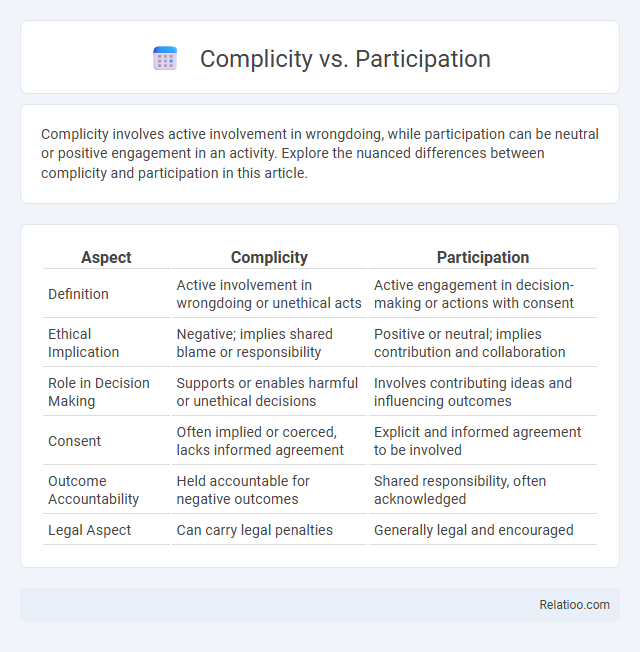Complicity involves active involvement in wrongdoing, while participation can be neutral or positive engagement in an activity. Explore the nuanced differences between complicity and participation in this article.
Table of Comparison
| Aspect | Complicity | Participation |
|---|---|---|
| Definition | Active involvement in wrongdoing or unethical acts | Active engagement in decision-making or actions with consent |
| Ethical Implication | Negative; implies shared blame or responsibility | Positive or neutral; implies contribution and collaboration |
| Role in Decision Making | Supports or enables harmful or unethical decisions | Involves contributing ideas and influencing outcomes |
| Consent | Often implied or coerced, lacks informed agreement | Explicit and informed agreement to be involved |
| Outcome Accountability | Held accountable for negative outcomes | Shared responsibility, often acknowledged |
| Legal Aspect | Can carry legal penalties | Generally legal and encouraged |
Understanding Complicity: Definition and Scope
Understanding complicity involves recognizing how an individual or group knowingly aids, facilitates, or encourages wrongful acts, distinguishing it from mere participation, which refers to direct involvement in the act itself. Complicity encompasses a broader scope, including passive roles such as providing resources or failing to prevent harm, thereby expanding legal and moral responsibility beyond direct perpetrators. Your awareness of these nuances is crucial for accurately assessing liability and ethical accountability in complex situations involving wrongdoing.
Participation Explained: Key Characteristics
Participation involves active engagement in an activity or event, where individuals directly contribute to the outcome through their actions or decisions. Key characteristics include intentional involvement, observable behavior, and a clear role within a group or process, distinguishing it from complicity, which implies indirect support or tacit approval of wrongdoing. Understanding participation is crucial in legal and social contexts, as it highlights responsibility and accountability in collaborative or collective settings.
Core Differences Between Complicity and Participation
Complicity involves knowingly assisting or encouraging the commission of a crime, establishing a shared intent with the primary offender, whereas participation refers more broadly to involvement in an activity, which may or may not be criminal. The core difference between complicity and participation lies in the degree of awareness and intent; complicity requires deliberate knowledge and intent to facilitate the criminal act, while participation can be passive or incidental without criminal intent. Understanding these distinctions is crucial for legal accountability, as complicity often carries heavier penalties due to its active contributory nature in the offense.
Legal Perspectives on Complicity vs Participation
Legal perspectives distinguish complicity as the intentional assistance or encouragement in the commission of a crime, whereas participation involves direct involvement or execution of the criminal act. Complicity often requires proof of knowledge and intent to further the crime, whereas participation centers on active engagement or carrying out criminal elements. Courts analyze degrees of involvement, with complicity attributing liability to those aiding or abetting without necessarily performing the criminal act themselves.
Ethical Implications of Being Complicit
Complicity involves knowingly enabling unethical actions, while participation actively engages in them, and mere presence implies passive involvement without direct endorsement. The ethical implications of being complicit center on your responsibility to prevent harm despite not directly executing the acts. Recognizing complicity demands critical reflection on personal accountability and the moral consequences of silent endorsement.
Participation in Group Dynamics: Roles and Responsibilities
Participation in group dynamics involves actively engaging in tasks and decision-making processes, reflecting your commitment to shared goals and responsibilities. Unlike complicity, which implies passive consent or involvement in wrongdoing, participation emphasizes constructive contribution and accountability within the group. Understanding these distinctions helps clarify your role and influence in collaborative environments.
Real-World Examples: Complicity vs Participation
In legal contexts, complicity involves intentionally assisting or facilitating a crime, whereas participation refers to direct involvement or active engagement in the criminal act. For example, in a bank robbery, the getaway driver who waits outside is an accomplice (complicity), while the person who enters the bank and demands money is a participant. Courts often distinguish these roles to determine the degree of culpability and appropriate sentencing.
Societal Consequences of Complicity
Complicity in societal issues involves enabling harmful actions by remaining inactive or indirectly supporting wrongdoing, which can lead to widespread erosion of trust and justice within communities. Participation, in contrast, entails direct engagement in actions, which may be either positive or negative depending on the intent and outcome, while complicity emphasizes passive or indirect involvement that still perpetuates harm. The societal consequences of complicity often include systemic inequality, normalization of unethical behavior, and diminished accountability, undermining social cohesion and fostering environments where injustice persists unchallenged.
Preventing Complicity: Strategies and Best Practices
Preventing complicity requires clear policies that define the legal and ethical boundaries of involvement in wrongful acts, coupled with rigorous training to ensure Your team understands these limits. Implementing robust monitoring systems and transparent reporting mechanisms helps detect early signs of participation or complicity, enabling swift corrective actions. Establishing a culture of accountability and ethical vigilance fosters proactive prevention and reinforces best practices in avoiding complicity risks.
Final Thoughts: Navigating the Line Between Complicity and Participation
Understanding the subtle distinctions between complicity and participation is crucial for ethical decision-making in complex situations. Your awareness of the degree of involvement and intent can help navigate legal and moral responsibilities effectively. Clear boundaries ensure accountability without unfairly penalizing passive engagement or uninformed actions.

Infographic: Complicity vs Participation
 relatioo.com
relatioo.com